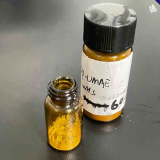Chinese VersionChina Suppliers > Hubei new DE sheng material science and technology co., LTD. > Application of acridine ester NSP-DMAE-NHS in chemiluminescence detection
- Search Product
-
-
- Region :China/Hubei
- Tel : +86-18971041571
- Fax :
- Email :vickyzhao@whdschem.com
- URL :
- Add :Guanggu United Science and Technology City C8, Ezhou City, Hubei Province
- Details for Application of acridine ester NSP-DMAE-NHS in chemiluminescence detection
-
Application of acridine ester NSP-DMAE-NHS in chemiluminescence detection
Category : Other Chemicals/Others

CAS NO : 194357-64-7 EC NO : MF : C30H26N2O9S MW : 590.6044 Specification : White Powder Packing : 500g/bottle Product description : NSP-DMAE-NHS is a newly developed acridine derivative based on traditional acridine ester AE. It has high luminescence efficiency, good stability, can label multiple proteins or antibodies, high detection sensitivity, and low background interference. Acridine ester has been widely proven to be a very useful chemiluminescent marker, with stability, labeling specificity, and detection sensitivity surpassing that of radioactive isotopes. NSP-DMAE-NHS chemiluminescence detection of acridine ester NSP-DMAE-NHS contains N-hydroxysuccinimide, also known as NHS ester, which can react with the primary amino group of proteins. Under alkaline conditions, NHS is replaced as a leaving group, and proteins form stable amide bonds with acridine esters. After the reaction is completed, excess acridine salts are removed through a desalination column. In the presence of alkaline hydrogen peroxide, acridine labeled proteins can self emit light without enzymatic catalysis. Therefore, the addition of excitation solution leads to the immediate release of approximately 430nm photons in the reaction system, and the protein concentration can be detected by counting the number of photons using a standard photometer. Because this luminescence process is very brief (the entire process is completed within 2 seconds), the sample must be placed directly in front of the photon detector inside the photometer. Proteins, peptides, antibodies, nucleic acids, and peptides can all be labeled with acridine esters. The labeled compound rapidly emits light under the excitation of alkaline hydrogen peroxide, and can be detected by collecting photons. Excited luminescence of acridine ester labeled proteins The NSP-DMAE-NHS labeled protein with acridine ester was completed in the labeling buffer and formed a coupling compound with it. The excess acridine ester was added to the termination buffer and purified through desalination to obtain the acridine ester labeled protein. Then, simply add the excitation solution: (0.01~0.1M) NaOH+0.05% H2O2 to generate a chemiluminescence reaction, which does not require the involvement of enzymes and has high luminescence efficiency. Uses : Chemiluminescence reagent Synonyms : NSP-DMAE-NHS;
- more>>Other Products
-
- • Biological buffer 3- [N, N-di (hydroxyethyl) amino] -2-hydroxypropanesulfonic acid DIPSO
- • Luminol Sodium Salt
- • 4-Aminophthalhydrazide
- • acridinium ester DMAE-NHS
- • acridinium ester NSP-DMAE-NHS
- • Acridine hydrochloride NSP-SA
- • Acridine hydrochloride NSP-SA-NHS
- • NSP-SA-ADH
- • acridinium ester ME-DMAE-NHS TOOS; 3-(N-Ethyl-3-Methylanilino)-2-Hydroxypropanesulfonic Acid Sodium Salt
- • TOPS; Sodium 3-(N-Ethyl-3-Methylanilino)Propanesulfonate; N-Ethyl-N-Sulfopropyl-M-Toluidine Sodium Salt
- • ADOS Sodium 3-(Ethyl(3-Methoxyphenyl)Amino)-2-Hydroxypropane-1-Sulfonate Dihydrate
- • ADPS N-Ethyl-N-(3-Sulfopropyl)-3-Methoxyaniline Sodium Salt
- • ALPS N-Ethyl-N-(3-Sulfopropyl)Aniline Sodium Salt; Sodium 3-(Ethyl(Phenyl)Amino)Propane-1-Sulfonate; Sodium
- • DAOS; Sodium 3-((3,5-Dimethoxyphenyl)(Ethyl)Amino)-2-Hydroxypropane-1-Sulfonate
- • HDAOS; N-(2-Hydroxy-3-Sulfopropyl)-3,5-Dimethoxyaniline Sodium Salt
- • MADB N,N-Bis(4-Sulfobutyl)-3,5-Dimethylaniline Disodium Salt
- • MAOS N-Ethyl-N-(2-Hydroxy-3-Sulfopropyl)-3,5-Dimethylaniline Sodium Salt Monohydrate
- • DAB 3,3',4,4'-Biphenyltetramine Tetrahydrochloride